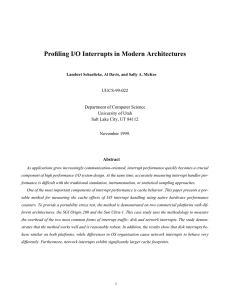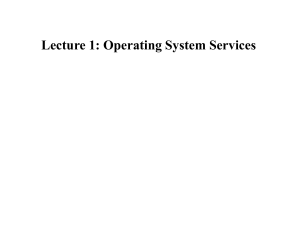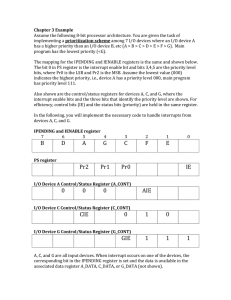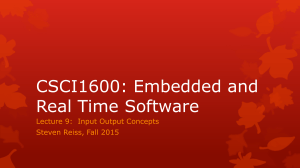Interrupts
advertisement
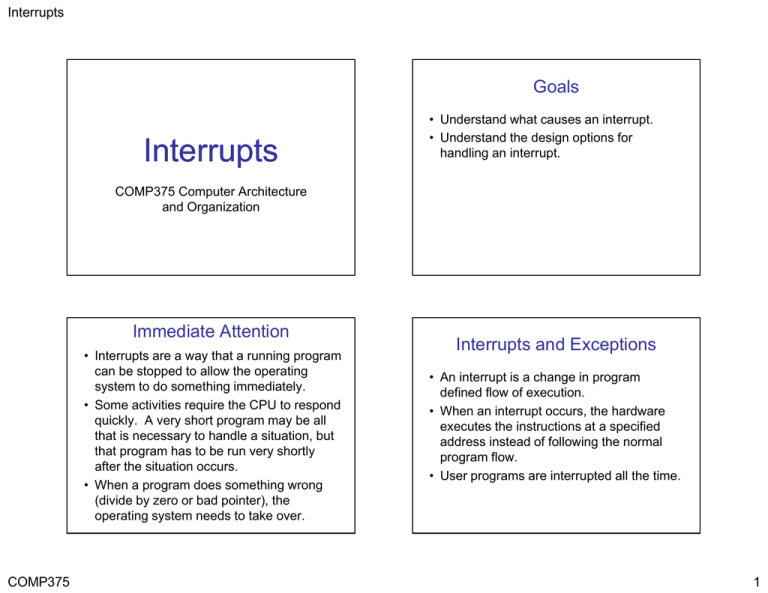
Interrupts Goals Interrupts • Understand what causes an interrupt. • Understand the design options for handling an interrupt. COMP375 Computer Architecture and dO Organization i ti Immediate Attention • Interrupts are a way that a running program can be stopped to allow the operating system to do something immediately immediately. • Some activities require the CPU to respond quickly. A very short program may be all that is necessary to handle a situation, but that program has to be run very shortly after the situation occurs. • When a program does something wrong (divide by zero or bad pointer), the operating system needs to take over. COMP375 Interrupts and Exceptions • An interrupt is a change in program d fi d flflow off execution. defined ti • When an interrupt occurs, the hardware executes the instructions at a specified address instead of following the normal program flow. • User programs are interrupted all the time. 1 Interrupts Transfer of Control via Interrupt Types of Interrupts • External – Generated by an I/O device • Internal – Exception within a program • Program Generated – Used to transfer control to the operating system graphic from Stallings textbook External Interrupts • I/O devices tell the CPU that an I/O requestt has h completed l t db by sending di an interrupt signal to the processor. • I/O errors may also generate an interrupt. • Most computers have a timer which interrupts the CPU every so many milliseconds. Internal Interrupts • When the hardware detects that the program is doing something wrong, it will usually generate an interrupt interrupt. – Arithmetic error – Addressing error – Page fault - Invalid Instruction - Hardware malfunction - Debugging • A Page Fault interrupt is not the result of a program error, but it does require the operating system to get control. • Internal interrupts are sometimes called exceptions. COMP375 2 Interrupts Program Generated Interrupts int Instruction • Most computers have an instruction that generates t an internal i t l iinterrupt. t t • Program generated interrupts are a means for user programs to call a function of the operating system • Some systems refer to these interrupts as a SuperVisor Call or SVC • The Intel Pentium int instruction generates t a program interrupts. i t t • This is the mechanism for a user program to call an operating system function. • The int instruction takes a one byte operand. operand • The bottom 1K (1024 bytes) of system memory is devoted to the storage of interrupt vectors. DOS Print Character Interrupt Action MOV AH,02 ; To select print character, ; move the th appropriate i t number, b 2 2, tto AH AH. MOV DL,"!" ; the character to output ; should be in register DL INT 21h ; call the interrupt. COMP375 • • When an interrupt occurs, the program counter t and d status t t flags fl are saved d in i a special location. New program counter and status flags are loaded. The location may be determined by the type of interrupt. 3 Interrupts Similar to Function Calls • A interrupt is similar to a function call, the return t address dd iis pushed h d on th the stack t k and d execution jumps to another location. • Interrupts can occur without warning. A program may be adding some numbers when an I/O device will generate an interrupt. Interrupt Service Routines • When an interrupt occurs, execution starts in an interrupt service routine (ISR) or interrupt handler. • The ISR is almost always in the OS. • The interrupt service routine processes the event or queues a program to process the event. • After an external interrupt, the service routine will return to the program. OS and Hardware Response • Hardware saves the current program counter t and d status t t flags. fl • Hardware loads new PC and flags. • OS saves the registers • OS determines cause of the interrupt • OS does something (depends on the interrupts) • OS restores the registers • OS executes an interrupt return instruction to load saved PC and flag values. COMP375 Interrupt Design Issues • • • • • When may interrupts be recognized? Where is the process state saved? What process state is saved? How is the handler’s entry point found? How is the program resumed? 4 Interrupts Recognizing Interrupts Instruction Cycle (with Interrupts) - State Diagram • An external event can signal the CPU to i t interrupt t att any time, ti even in i the th middle iddl off an instruction. • External interrupts take effect at the end of an instruction. • Some long repeating instructions provide an opportunity to interrupt between iterations. graphic from Stallings textbook Internal Interrupts • Internal interrupts are signaled during an i t ti instruction. • Execution of an instruction can raise an arithmetic error interrupt. • Page faults can be created during the instruction fetch, fetch operand fetch or operand store or all of the above. COMP375 Saving Process State • Interrupts can be considered similar to a function call. • The program counter and processor state register can be saved on the stack. • It is unwise to save system information in user address space, thus the interrupt i f information i cannot b be saved d on the h user stack. • A special OS stack can be used. 5 Interrupts What to Save Special Save Areas • Some architectures provide a special fixed l location ti tto save th the executing ti program’s ’ state. • Some processors, such as MIPS, save the interrupt address in a special register, the exception program counter (EPC). • A fixed location can be overridden if you have nested interrupts. ISR Entry Point • The processor needs to save enough information so the executing program can b resumed. be d • Information usually saved: – Program Counter – Status bits – Registers (by OS) – Addressing environment (by OS) • Current process may need to be suspended Interrupt Vector Points to ISRs // Divide error • It is possible for all interrupt service routines t start to t t att the th same location. l ti The Th software ft can determine what kind of interrupt. • The hardware can assist by using the interrupt type as an index into a table of ISR addresses. • Each interrupt may have a different ISR entry point or classes of interrupts may have a common entry point. Interrupt Vector 1: 1234 … Interrupt Service Routine … 2: 2341 // Floating Point overflow… 3: 5634 … Interrupt Service Routine … 4: 4327 // Bad Address 5: 4644 … Interrupt Service Routine … etc. // Page Fault … Interrupt Service Routine … // Incorrect opcode … Interrupt Service Routine … COMP375 6 Interrupts Interrupt Vector • In the Intel Pentium each interrupt type h a number has b associated i t d with ith itit, called ll d th the interrupt request queue (IRQ) number. • When a device interrupts, the IRQ is used as an index into a table of ISR addresses. • The operand of the int instruction provides an index into a table of ISR addresses. Multiple Interrupts • An interrupt event can occur while the processor is handling a previous interrupt. • If the return address is always stored at a fixed location, the occurrence of an interrupt while handling a previous interrupt will overwrite the previous return address. • Most interrupt service routines start with interrupts disabled. This prevents an interrupt service routine from being interrupted. COMP375 Resuming Execution • On external interrupts, the OS generally resumes the running process. The next instruction of the process is executed executed. • For some internal interrupts, it may not be possible to restart the program (i.e. addressing error). • For some interrupts (i (i.e. e page faults) you want to re-execute the instruction. • For other interrupts (i.e. overflow) you may want to execute the next instruction. Masking Interrupts • Some interrupts can be temporarily di bl d M disabled. Mostt processors can di disable bl external interrupts. • Most internal interrupts cannot be disabled. • It is generally problematic to disable interrupts for a lengthy period of time. 7 Interrupts Intel EFLAGS Register Missing Interrupts • Many devices will interrupt once per event. processor fails to acknowledge g the If the p interrupt before the next event, knowledge of the first interrupt is lost. Interrupt Priorities Device Speed • Most systems prioritize the interrupts. • If two interrupts happen at the same time, the interrupt with the highest priority will be serviced first. graphic from Stallings textbook COMP375 8
